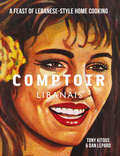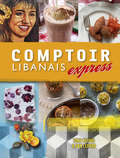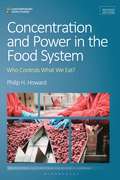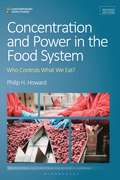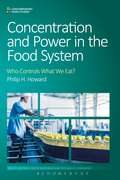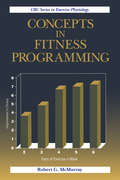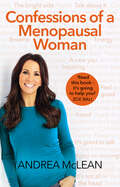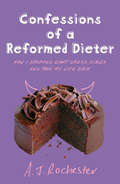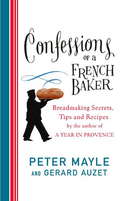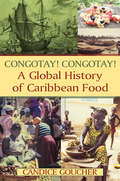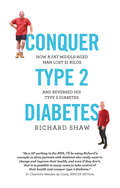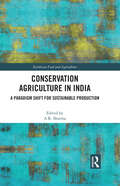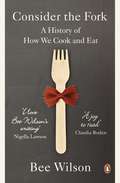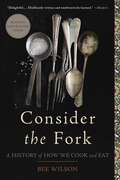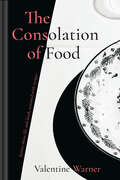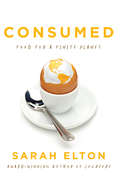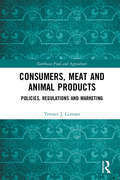- Table View
- List View
Comptoir Libanais: A Feast Of Lebanese-style Home Cooking
by Dan Lepard Tony KitousFor over a decade Tony Kitous has been Britain’s most passionate provider of contemporary Lebanese and North African food. His restaurants were the first in London to merge traditional Arabic cooking with easy contemporary eating. There are now seven Comptoir Libanais restaurants in London with more planned in the next 18 months.The success of Comptoir Libanais restaurants centres on an easy, relaxed cafe-style of food: light Arabic home cooking mixed with familiar bistro flavours and techniques. Tony Kitous’ recipes combine fresh vibrant vegetable dishes with simple grills, flat breads, grains, herb salads and dips. Pastries are richly flavoured and delicate, made with syrups and spices. Absolutely the menu for today and adaptable for the home cook.Containing eighty recipes, each one with a full-page photograph, Comptoir Libanais makes achieving a great result easy at home. Tony Kitous’ approach and shortcuts inspire new ways to prepare readily-available ingredients: big on spices, fresh herbs and bright citrus flavours drawn from traditional Arabic cooking. The book is strong on vegetarian and vegan dishes, alongside simple grilled or poached meats, fish and beautiful sauces that are quick to prepare or make in advance. If you want a quick snack for yourself, or an extraordinary celebration feast, all the how-to you’ll need is here. Bringing together the passion of owner Tony Kitous, the extraordinary designs of award-winning graphic artist Rana Salam, and bestselling author and photographer Dan Lepard, the Comptoir Libanais cookbook blends a vibrant culinary tradition with modern flavours and cooking methods
Comptoir Libanais Express
by Tony Kitous Dan Lepard'Comptoir Express is about those times when I need to race around the kitchen and prepare great food in a hurry. Inspired by the best dishes and ingredients I've eaten in the Lebanon and at Comptoir Libanais, it's about simple ingredients and preparing in advance to take the hassle out of cooking delicious meals.'Tony Kitous is a rising star in the culinary world. Screen-tested for a series on BBC and appearing in 'Food and Drink' he is tipped to be one of the new faces of 2014.Pages on everyday key ingredients, like aubergines or yoghurt, with ideas that transform them from their shopping-bag state into easily prepared components of a fantastic meal.Filled with simple ideas and dishes, you can combine as you like, making relaxed meals that are endlessly variable each time you cook them.
Computational Fluid Dynamics Applications in Bio and Biomedical Processes: Biotechnology Applications
by Satya Eswari Jujjavarapu Tukendra Kumar Sharda GuptaThis book covers emerging areas in novel design and their hydrodynamic properties relevant to bioreactors, environmental system, electrochemical systems, food processing and biomedical engineering. This book uses an interdisciplinary approach to provide a comprehensive prospective simulation modeling and hydrodynamic study in advanced biotechnological process and includes reviews of the most recent state of art in modeling and simulation of flows in biological process, such as CFD. Written by internationally recognized researchers in the field, each chapter provides a strong introductory section that is useful to both readers currently in the field and readers interested in learning more about these areas.
Concentration and Power in the Food System: Who Controls What We Eat?, Revised Edition (Contemporary Food Studies: Economy, Culture and Politics)
by Philip H. HowardWho controls what we eat? This book reveals how dominant corporations, from the supermarket to the seed industry, exert control over contemporary food systems. It analyzes the strategies these firms are using to reshape society in order to further increase their power, particularly in terms of their bearing upon the more vulnerable sections of society, such as recent immigrants, ethnic minorities and those of lower socioeconomic status. Yet this study also shows that these trends are not inevitable. Opposed by numerous efforts, from microbreweries to seed saving networks, it explores how opposition to this has encouraged even the most powerful firms to make small but positive changes.This revised edition has been updated to reflect recent developments in the food system, as well as the broad political economic forces that shape them. It also examines the rapidly changing technologies, such as Big Data and automation, which have the potential to reinforce, as well as to challenge, the power of the largest firms.
Concentration and Power in the Food System: Who Controls What We Eat?, Revised Edition (Contemporary Food Studies: Economy, Culture and Politics)
by Philip H. HowardWho controls what we eat? This book reveals how dominant corporations, from the supermarket to the seed industry, exert control over contemporary food systems. It analyzes the strategies these firms are using to reshape society in order to further increase their power, particularly in terms of their bearing upon the more vulnerable sections of society, such as recent immigrants, ethnic minorities and those of lower socioeconomic status. Yet this study also shows that these trends are not inevitable. Opposed by numerous efforts, from microbreweries to seed saving networks, it explores how opposition to this has encouraged even the most powerful firms to make small but positive changes.This revised edition has been updated to reflect recent developments in the food system, as well as the broad political economic forces that shape them. It also examines the rapidly changing technologies, such as Big Data and automation, which have the potential to reinforce, as well as to challenge, the power of the largest firms.
Concentration and Power in the Food System: Who Controls What We Eat? (Contemporary Food Studies: Economy, Culture and Politics)
by Professor Philip H. HowardNearly every day brings news of another merger or acquisition involving the companies that control our food supply. Just how concentrated has this system become? At almost every key stage of the food system, four firms alone control 40% or more of the market, a level above which these companies have the power to drive up prices for consumers and reduce their rate of innovation. Researchers have identified additional problems resulting from these trends, including negative impacts on the environment, human health, and communities.This book reveals the dominant corporations, from the supermarket to the seed industry, and the extent of their control over markets. It also analyzes the strategies these firms are using to reshape society in order to further increase their power, particularly in terms of their bearing upon the more vulnerable sections of society, such as recent immigrants, ethnic minorities and those of lower socioeconomic status. Yet this study also shows that these trends are not inevitable. Opposed by numerous efforts, from microbreweries to seed saving networks, it explores how such opposition has encouraged the most powerful firms to make small but positive changes.
Concepts in Fitness Programming (Exercise Physiology Ser. #1)
by Robert G. McMurrayConcepts in Fitness Programming presents comprehensive material about various aspects of exercise testing and prescription in a simple, straightforward manner. Intended for individuals who design exercise and fitness programs but who lack extensive background in fitness training, this book provides a wealth of knowledge beyond the basic "how to's"
Concepts in Fitness Programming
by Robert G. McMurrayConcepts in Fitness Programming presents comprehensive material about various aspects of exercise testing and prescription in a simple, straightforward manner. Intended for individuals who design exercise and fitness programs but who lack extensive background in fitness training, this book provides a wealth of knowledge beyond the basic "how to's"
Confessions of a Menopausal Woman: Everything you want to know but are too afraid to ask…
by Andrea McLeanThe menopause. There - we've said it. It's a huge part of every woman's life and yet it remains one of society's last taboos. An emotionally complex issue that can trigger a whole host of physical and mental side effects, it's a big deal. So why aren't we talking about it? Talking about stuff is what women do best; we share and offload, we laugh and we bond over the ridiculous and incredible things our bodies go through. Hearing other people's experiences is what makes our own so much more bearable - because we know that we aren't alone. This is the book that Andrea McLean wished for as she found herself in uncharted territory, grappling with the physical aftershock of a hysterectomy and the psychological fallout of a difficult menopause. After announcing live on Loose Women that she would be absent from the screen as she recovered from surgery, Andrea was inundated with letters from other women struggling with the realities of the menopause, who were delighted that someone was finally talking openly and frankly about it. Typically candid, and including tips and tricks on diet, exercise and even your sex life, in Confessions of a Menopausal Woman Andrea brings her trademark humour and honesty to a very hot topic.
Confessions of a Reformed Dieter: How I Dropped Eight Dress Sizes And Took My Life Back
by A J Rochester'I love food. Even worse, I love junk food. If lard could be double deep-fried I would eat it. If I could deep-fry headache pills I would. So it's no wonder I'm now the size of a small yet economically viable continent...'When A. J. Rochester is selected to feature in a television series on obesity, she is at first appalled and then resolved. At 109 kilos (17 stone), she knows she needs to lose weight - not because she yearns to become a twiglet but so she can keep up with her little boy and turn her life around at last. But after years of fighting a losing battle with the flab, A. J. knows she needs a miracle. So she decides to ditch the 'quick-fix' diets and the faddy exercise equipment and try a new approach - one that involves discovering her own inner strengths. It may not be easy - but it pays off. Confessions of a Reformed Dieter charts the highs, lows and plateaus of A. J.'s incredible journey, from overcoming an early setback - waking up in hospital with a broken leg after a drunken binge - to the triumph of shedding the first, and last, kilo.
Confessions Of A French Baker: Breadmaking secrets, tips and recipes
by Peter MayleIn Cavaillon, there are seventeen bakers listed in the Pages Jaunes, but we had been told that one establishment was ahead of all the rest in terms of choice and excellence, a vertiable palais de pain. At Chez Auzet, so they said, the baking and eating of breads and pastries had been elevated to the status of a minor religion.'This was written in 1988 in one of Peter Mayle's notebooks as he researched A Year in Provence. And ever since his first visit, the Boulangerie Auzet has remained one of his favourite places in the world. Many more people came to visit the bakery after A Year in Provence was published, all wanting more than just bread. They wanted ingredients, recipes, tips - anything that might help them recreate Boulangerie Auzet in their own kitchens. Confessions of a French Baker will do just that. It will decribe how to make bread and pastries, the secret of handling dough correctly, the history of the shop, some anecdotes, hints and tips, in short, a way of bringing Boulangerie Auzet into your own home.
Confetti Cakes For Kids: Delightful Cookies, Cakes, and Cupcakes from New York City's Famed Bakery
by Christie Matheson Elisa StraussElisa Strauss of Confetti Cakes has created confections as elaborate as a platter of sushi, a wine bottle in a crate, and a designer handbag. Now she focuses her talents on her younger fans with this enchanting collection of cakes, cookies, and cupcakes for kids. Strauss starts readers off with 20 delicious recipes and all the basic techniques needed to complete any project in the book. Then she offers step-by-step instructions for 24 jaw-dropping designs that can become the centerpiece of any celebration. Projects span the imagination -- from a charming sock monkey, to an MP3 player, to playful hula gingerbread girls and boys -- and will appeal to anyone looking for the perfect way to thrill a child with a delectable, spectacular creation.
Congotay! Congotay! A Global History of Caribbean Food
by Candice GoucherSince 1492, the distinct cultures, peoples, and languages of four continents have met in the Caribbean and intermingled in wave after wave of post-Columbian encounters, with foods and their styles of preparation being among the most consumable of the converging cultural elements. This book traces the pathways of migrants and travellers and the mixing of their cultures in the Caribbean from the Atlantic slave trade to the modern tourism economy. As an object of cultural exchange and global trade, food offers an intriguing window into this world. The many topics covered in the book include foodways, Atlantic history, the slave trade, the importance of sugar, the place of food in African-derived religion, resistance, sexuality and the Caribbean kitchen, contemporary Caribbean identity, and the politics of the new globalisation. The author draws on archival sources and European written descriptions to reconstruct African foodways in the diaspora and places them in the context of archaeology and oral traditions, performance arts, ritual, proverbs, folktales, and the children's song game "Congotay." Enriching the presentation are sixteen recipes located in special boxes throughout the book.
Congotay! Congotay! A Global History of Caribbean Food
by Candice GoucherSince 1492, the distinct cultures, peoples, and languages of four continents have met in the Caribbean and intermingled in wave after wave of post-Columbian encounters, with foods and their styles of preparation being among the most consumable of the converging cultural elements. This book traces the pathways of migrants and travellers and the mixing of their cultures in the Caribbean from the Atlantic slave trade to the modern tourism economy. As an object of cultural exchange and global trade, food offers an intriguing window into this world. The many topics covered in the book include foodways, Atlantic history, the slave trade, the importance of sugar, the place of food in African-derived religion, resistance, sexuality and the Caribbean kitchen, contemporary Caribbean identity, and the politics of the new globalisation. The author draws on archival sources and European written descriptions to reconstruct African foodways in the diaspora and places them in the context of archaeology and oral traditions, performance arts, ritual, proverbs, folktales, and the children's song game "Congotay." Enriching the presentation are sixteen recipes located in special boxes throughout the book.
Conquer Type 2 Diabetes: how a fat, middle-aged man lost 31 kilos and reversed his type 2 diabetes
by Richard ShawType-2 diabetes doesn’t have to be a lifelong condition; for many people, especially those who have been recently diagnosed, it’s possible to reverse the symptoms of this malignant disease. But how can that be done? In 2017 the author, inspired by results obtained from research done at Newcastle University, UK, decided to try and kick the disease by following a carefully structured, low-carb, whole-food diet and starting a modest exercise regime. Conquer Type 2 Diabetes describes what he did to lose 31 kilos and all his diabetes signs (high blood sugar, high cholesterol, high blood pressure) and symptoms. It explains how he managed carbs, calories, sugars and weight loss, plus the light exercise regime he adopted to strengthen his chances. In so doing he answers the question so many people have been asking him – what did you do to shed an illness that affects more than 400 million people worldwide and is conventionally regarded as incurable and progressive? The book includes the author’s meal and exercise plan and 40 mouth-watering low-carb recipes to ensure eating can remain a pleasure and something to look forward to while reversing type 2.
Conservation Agriculture in India: A Paradigm Shift for Sustainable Production (Earthscan Food and Agriculture)
by A. R. SharmaThis book examines the current situation, levels of adoption, management practices, and the future outlook of conservation agriculture in India, and also in other tropical and subtropical regions of the world. While conservation agriculture is proposed as an important means to combat climate change, improve crop productivity and food affordability, and to protect the environment, the adoption of conservation agriculture in India, and south-east Asia more broadly, has been slow. This volume reflects on the current status of conservation agriculture in India, asking why adoption has been slow and putting forward strategies to improve its uptake. The chapters cover the various aspects of crop management such as soil, water, nutrients, weeds, crop residues, machinery, and energy, in a range of environments, including irrigated and rainfed regions. The impact of climate change and the economic considerations behind the adoption of conservation agriculture are also discussed. The volume concludes by discussing the future outlook for conservation agriculture in India, in particular drawing out parallels with other tropical and subtropical regions of the world. This book will be of great interest to students and scholars of conservation agriculture, sustainable agriculture, crop and soil management, and environmental and natural resource management.
Conservation Agriculture in India: A Paradigm Shift for Sustainable Production (Earthscan Food and Agriculture)
by A. R. SharmaThis book examines the current situation, levels of adoption, management practices, and the future outlook of conservation agriculture in India, and also in other tropical and subtropical regions of the world. While conservation agriculture is proposed as an important means to combat climate change, improve crop productivity and food affordability, and to protect the environment, the adoption of conservation agriculture in India, and south-east Asia more broadly, has been slow. This volume reflects on the current status of conservation agriculture in India, asking why adoption has been slow and putting forward strategies to improve its uptake. The chapters cover the various aspects of crop management such as soil, water, nutrients, weeds, crop residues, machinery, and energy, in a range of environments, including irrigated and rainfed regions. The impact of climate change and the economic considerations behind the adoption of conservation agriculture are also discussed. The volume concludes by discussing the future outlook for conservation agriculture in India, in particular drawing out parallels with other tropical and subtropical regions of the world. This book will be of great interest to students and scholars of conservation agriculture, sustainable agriculture, crop and soil management, and environmental and natural resource management.
Consider the Fork: A History of How We Cook and Eat
by Bee WilsonBee Wilson is the food writer and historian who writes as the 'Kitchen Thinker' in the Sunday Telegraph, and is the author of Swindled!. Her charming and original new book, Consider the Fork, explores how the implements we use in the kitchen have shaped the way we cook and live. A wooden spoon - most trusty and loveable of kitchen implements - looks like the opposite of 'technology', as the word is normally understood. But look closer. Is it oval or round? Does it have an extra-long handle to give your hand a place of greater safety from a hot skillet? Or a pointy bit at one side to get the lumpy bits in the corner of the pan? It took countless inventions to get to the well-equipped kitchens we have now, where our old low-tech spoon is joined by mixers, freezers and microwaves, but the story of human invention in the kitchen is largely unseen. Discovering the histories of our knives, ovens and kitchens themselves, Bee Wilson explores, among many other things, why the French and Chinese have such different cultures of the knife; and why Roman kitchens contain so many implements we recognize. Encompassing inventors, scientists, cooks and chefs, this is the previously unsung history of our kitchens.
Consider the Fork: A History of How We Cook and Eat
by Bee WilsonAward-winning food writer Bee Wilson's secret history of kitchens, showing how new technologies - from the fork to the microwave and beyond - have fundamentally shaped how and what we eat.Since prehistory, humans have braved sharp knives, fire, and grindstones to transform raw ingredients into something delicious--or at least edible. But these tools have also transformed how we consume, and how we think about, our food. In Consider the Fork, award-winning food writer Bee Wilson takes readers on a wonderful and witty tour of the evolution of cooking around the world, revealing the hidden history of objects we often take for granted. Technology in the kitchen does not just mean the Pacojets and sous-vide machines of the modern kitchen, but also the humbler tools of everyday cooking and eating: a wooden spoon and a skillet, chopsticks and forks. Blending history, science, and personal anecdotes, Wilson reveals how our culinary tools and tricks came to be and how their influence has shaped food culture today. The story of how we have tamed fire and ice and wielded whisks, spoons, and graters, all for the sake of putting food in our mouths, Consider the Fork is truly a book to savor.
The Consolation of Food: Stories About Life And Death, Seasoned With Recipes
by Valentine Warner‘Time spent with Val is not just time spent in wonderful company but with an intelligent, proper cook – I could sit at a table with this man for days. He cooks like he eats; just delicious, delicious food.’ Angela Hartnett, Chef
Consumed: Food for a Finite Planet
by Sarah EltonBy 2050, the world population is expected to reach nine billion. And the challenge of feeding this rapidly growing population is being made greater by climate change, which will increasingly wreak havoc on the way we produce our food. At the same time, we have lost touch with the soil—few of us know where our food comes from, let alone how to grow it—and we are at the mercy of multinational corporations who control the crops and give little thought to the damage their methods are inflicting on the planet. Our very future is at risk. In Consumed, Sarah Elton walks fields and farms on three continents, not only investigating the very real threats to our food, but also telling the little-known stories of the people who are working against time to create a new and hopeful future. From the mountains of southern France to the highlands of China, from the crowded streets of Nairobi to the banks of the St. Lawrence River in Quebec, we meet people from all walks of life who are putting together an alternative to the omnipresent industrial food system. In the arid fields of rural India we meet a farmer who has transformed her community by selling organic food directly to her neighbors. We visit a laboratory in Toronto where scientists are breeding a new kind of rice seed that they claim will feed the world. We learn about Italy’s underground food movement; how university grads are returning to the fields in China, Greece, and France; and how in Detroit, plots of vacant land planted with kale and carrots can help us see what’s possible. Food might be the problem, but as Elton shows, it is also the solution. The food system as we know it was assembled in a few decades—and if it can be built that quickly, it can be reassembled and improved in the same amount of time. Elton here lays out the targets we need to meet by the year 2050. The stories she tells give us hope for avoiding a daunting fate and instead help us to believe in a not-too-distant future when we can all sit at the table.
Consumed: Food for a Finite Planet
by Sarah EltonBy 2050, the world population is expected to reach nine billion. And the challenge of feeding this rapidly growing population is being made greater by climate change, which will increasingly wreak havoc on the way we produce our food. At the same time, we have lost touch with the soil—few of us know where our food comes from, let alone how to grow it—and we are at the mercy of multinational corporations who control the crops and give little thought to the damage their methods are inflicting on the planet. Our very future is at risk. In Consumed, Sarah Elton walks fields and farms on three continents, not only investigating the very real threats to our food, but also telling the little-known stories of the people who are working against time to create a new and hopeful future. From the mountains of southern France to the highlands of China, from the crowded streets of Nairobi to the banks of the St. Lawrence River in Quebec, we meet people from all walks of life who are putting together an alternative to the omnipresent industrial food system. In the arid fields of rural India we meet a farmer who has transformed her community by selling organic food directly to her neighbors. We visit a laboratory in Toronto where scientists are breeding a new kind of rice seed that they claim will feed the world. We learn about Italy’s underground food movement; how university grads are returning to the fields in China, Greece, and France; and how in Detroit, plots of vacant land planted with kale and carrots can help us see what’s possible. Food might be the problem, but as Elton shows, it is also the solution. The food system as we know it was assembled in a few decades—and if it can be built that quickly, it can be reassembled and improved in the same amount of time. Elton here lays out the targets we need to meet by the year 2050. The stories she tells give us hope for avoiding a daunting fate and instead help us to believe in a not-too-distant future when we can all sit at the table.
Consumed: Food for a Finite Planet
by Sarah EltonBy 2050, the world population is expected to reach nine billion. And the challenge of feeding this rapidly growing population is being made greater by climate change, which will increasingly wreak havoc on the way we produce our food. At the same time, we have lost touch with the soil—few of us know where our food comes from, let alone how to grow it—and we are at the mercy of multinational corporations who control the crops and give little thought to the damage their methods are inflicting on the planet. Our very future is at risk. In Consumed, Sarah Elton walks fields and farms on three continents, not only investigating the very real threats to our food, but also telling the little-known stories of the people who are working against time to create a new and hopeful future. From the mountains of southern France to the highlands of China, from the crowded streets of Nairobi to the banks of the St. Lawrence River in Quebec, we meet people from all walks of life who are putting together an alternative to the omnipresent industrial food system. In the arid fields of rural India we meet a farmer who has transformed her community by selling organic food directly to her neighbors. We visit a laboratory in Toronto where scientists are breeding a new kind of rice seed that they claim will feed the world. We learn about Italy’s underground food movement; how university grads are returning to the fields in China, Greece, and France; and how in Detroit, plots of vacant land planted with kale and carrots can help us see what’s possible. Food might be the problem, but as Elton shows, it is also the solution. The food system as we know it was assembled in a few decades—and if it can be built that quickly, it can be reassembled and improved in the same amount of time. Elton here lays out the targets we need to meet by the year 2050. The stories she tells give us hope for avoiding a daunting fate and instead help us to believe in a not-too-distant future when we can all sit at the table.
Consumed: Food for a Finite Planet
by Sarah EltonBy 2050, the world population is expected to reach nine billion. And the challenge of feeding this rapidly growing population is being made greater by climate change, which will increasingly wreak havoc on the way we produce our food. At the same time, we have lost touch with the soil—few of us know where our food comes from, let alone how to grow it—and we are at the mercy of multinational corporations who control the crops and give little thought to the damage their methods are inflicting on the planet. Our very future is at risk. In Consumed, Sarah Elton walks fields and farms on three continents, not only investigating the very real threats to our food, but also telling the little-known stories of the people who are working against time to create a new and hopeful future. From the mountains of southern France to the highlands of China, from the crowded streets of Nairobi to the banks of the St. Lawrence River in Quebec, we meet people from all walks of life who are putting together an alternative to the omnipresent industrial food system. In the arid fields of rural India we meet a farmer who has transformed her community by selling organic food directly to her neighbors. We visit a laboratory in Toronto where scientists are breeding a new kind of rice seed that they claim will feed the world. We learn about Italy’s underground food movement; how university grads are returning to the fields in China, Greece, and France; and how in Detroit, plots of vacant land planted with kale and carrots can help us see what’s possible. Food might be the problem, but as Elton shows, it is also the solution. The food system as we know it was assembled in a few decades—and if it can be built that quickly, it can be reassembled and improved in the same amount of time. Elton here lays out the targets we need to meet by the year 2050. The stories she tells give us hope for avoiding a daunting fate and instead help us to believe in a not-too-distant future when we can all sit at the table.
Consumers, Meat and Animal Products: Policies, Regulations and Marketing (Earthscan Food and Agriculture)
by Terence J. CentnerThis book addresses the production practices employed in the production of food animals and animal products that enable marketers to sell a variety of products to meet consumer demand. Food animal production practices have come under increased scrutiny by consumers who object to inputs and practices. The industry has been a proponent of using technologies to reduce production costs, resulting in lower-priced meat and animal food products, and now consumers are starting to look at other objectives. This book considers the key issues of concern to consumers, including the treatment of animals, the use of antibiotics, feed additives and hormones, and how these are monitored, regulated, and communicated to consumers. It also reviews labeling and information provided to consumers, including organic, genetic engineering, welfare standards, and place of origin. While the main focus is on the United States, there are descriptions of European practices and legislation. Overall, it aims to provide an objective and balanced appraisal, which will be of interest to advanced students and researchers in agricultural, food and environmental economics, law and policy, and animal production and welfare. It will also be very useful for early career professionals in the food and agricultural sectors.
